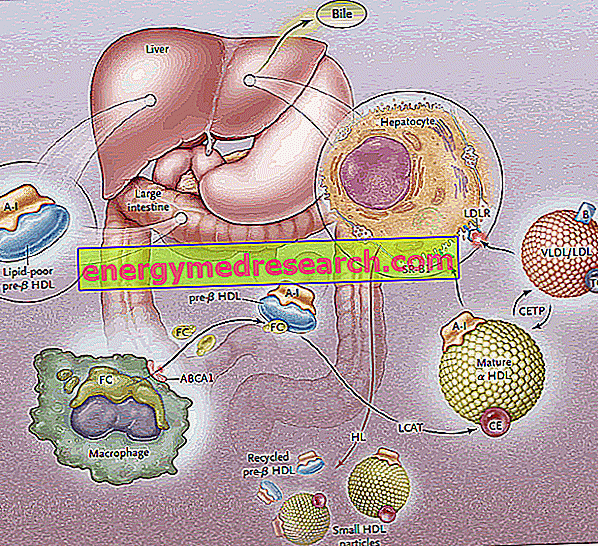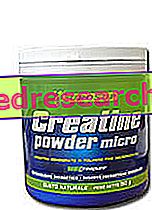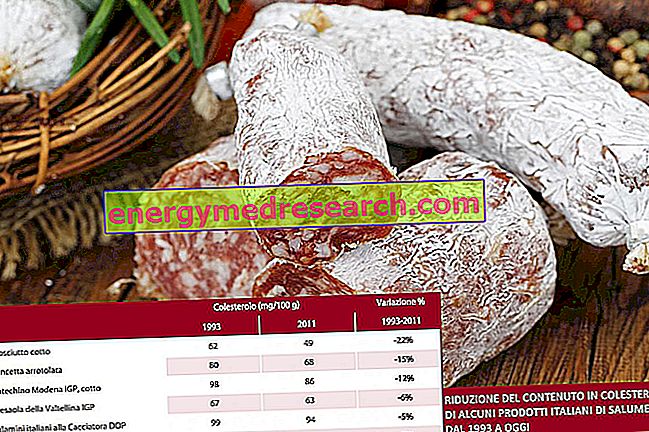Reverse cholesterol transport (RCT) is the process by which cholesterol is removed from peripheral tissues, through its incorporation into HDL lipoproteins and subsequent transport to the liver for biliary excretion.
Peripheral cells, like all non-intestinal or hepatic cells, are unable to degrade excess cholesterol; therefore, for the maintenance of cellular homeostasis, the presence of a mechanism dedicated to the removal of cholesterol from the cells is essential. This mechanism, aimed at the hepatic recovery of excess peripheral cholesterol, is called "reverse cholesterol transport" (RCT: reverse cholesterol transport ).
Let's examine the process in detail.
The biosynthesis of HDL lipoproteins passes through the synthesis and initial secretion of the main protein components (apoproteins), followed by the extracellular acquisition of lipids (phospholipids and cholesterol) which leads to the assembly and generation of mature HDL particles.
The first stage of reverse cholesterol transport consists in the production, by the intestine and the liver, of discoid precursors of HDL, which on their surface expose apoproteins (mainly ApoA-I); precursor molecules of HDL called pre-B-HDL are thus released, which incorporate very small amounts of cholesterol and lipids, especially phospholipids. The presence of these precursor molecules at the peripheral level promotes the transfer of excess free cholesterol (FC) - escaping from peripheral tissue cells - to apo AI, through the intervention of a membrane transporter called ATP-binding cassette A1 (ABCA1 ). This transporter is located on the cell surface and in the Golgi membranes, and can transport the lipids from the Golgi apparatus to the cell membrane, facilitating their efflux. At this point, as soon as the free cholesterol enters the native HDLs, a plasmatic enzyme of hepatic origin intervenes, called plasma lecithin-cholesterol acyltransferase or more simply LCAT; this enzyme converts the free cholesterol incorporated into the pre-B-HDL into cholesterol esters, transforming the pre-B-HDL into their mature α-HDL form; in practice, the continuous accumulation of cholesterol in the lipoprotein core converts the discoid HDL into spherical and plump particles, which can further acquire apoproteins from the lipoprotein particles rich in triglycerides and fuse together. In the whole process the apolipoprotein AI plays a key role, stimulating both the activity of the ABCA1 transporter and that of the LCAT. Since ApoAI is the most widely represented apolipoprotein in HDL, its plasma concentration is directly related to HDL cholesterol levels.
PLEASE NOTE: the esterification process is fundamental to prevent the redistribution of cholesterol from HDL to the plasma membrane; this mechanism exploits the fatty acid in position two present in the phosphatidylcholine molecules.
The LCAT-mediated esterification process then transforms the pre-B-HDL molecules into their "mature" α-HDL spherical form. These lipoproteins are then transported to the liver, where they release cholesterol, according to two distinct routes.
In a first case, HDL rich in esterified cholesterol yields this lipid to lipoproteins rich in triglycerides (very low density and low density lipoproteins), then intercepted by the liver through specific receptors (LDL-R) and removed from the circulation. The aim is to convey peripheral cholesterol to the liver via the LDL receptor system, then "discharge" the HDL from excess cholesterol to the peripheral level, so as to make them available again to receive it from the tissues; emptying itself of cholesterol, HDLs accept triglycerides in exchange and this happens thanks to the cholesterol ester transfer protein (CETP). The task of this protein is therefore to promote the redistribution and equilibrium of cholesterol esters and triglycerides between the HDL, LDL, IDL, VLDL, chylomicron and chylomicron lipoproteins, leading, as a net result, to an enrichment in HDL triglycerides, to the detriment of cholesterol esters, and a reduction in HDL size.
The second pathway involves hepatic SR-B1 receptors for HDL rich in esterified cholesterol, in the absence of concomitant degradation of the protein portion of HDL, which is then recycled. In practice this enzyme allows you to empty the HDLs from their content and regenerate new pre-B-HDLs. Part of the HDL and the ApoA-I is however internalized and degraded at the lysosomal level, both in the hepatic and renal cells. The uptake mediated by SR-B1 is made more efficient by the activity of the hepatic lipase, capable of remodeling the HDL by hydrolyzing the surface phospholipids and allowing the flow of esterified cholesterol from the lipoprotein core towards the plasma membrane (it is hypothesized, between the other, that ApoE is also involved in selective uptake, as mice deficient for the ApoE gene show a reduction in the efficacy of this pathway). SR-BI is mainly expressed in the liver, adrenal glands and ovary.




